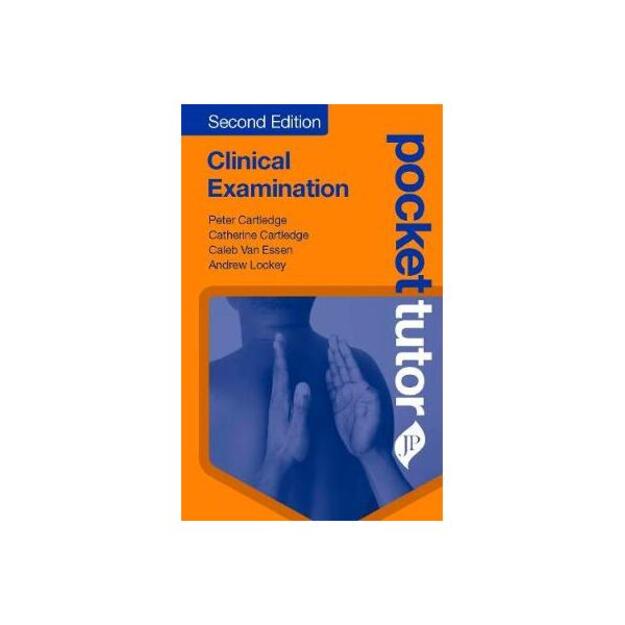
Prekės kodas: 9781909836785
Turimas kiekis: Prekė sandėlyje
| Kalba: | EN |
| Leidėjas: | Jp Medical Ltd |
| Specifikacija | |
| Autorius | Andrew Lockey, Peter Cartledge, Caleb Van Essen, Catherine Cartledge |
| Išleista | 2019 |
| Formatas | LT |
| Viršelis | Minkštas |
| Puslapiai | 350 |
Titles in the Pocket Tutor series give practical guidance on subjects that medical students and foundation doctors need help with 'on the go', at a highly-affordable price that puts them within reach of those rotating through modular courses or working on attachment. Topics reflect information needs stemming from today's integrated undergraduate and foundation courses: Common presentations Investigation options (e.g. ECG, imaging) Clinical and patient-orientated skills (e.g. examinations, history-taking) The highly-structured, bite-size content helps novices combat the 'fear factor' associated with day-to-day clinical training and provides a detailed resource that students and junior doctors can carry in their pocket. Key points Practical, accessible guide to examining the patient, which remains the bedrock of diagnosis and clinical evaluation Consistent chapter organisation: each body system chapter starts with relevant basic science, then highlights key signs before summarising examination technique Fully-updated second edition features new sections on sepsis evaluation, examination of elderly patients; tips on paediatric consultations; and all illustrations now in full colour. Preface v Acknowledgements xi Chapter 1 First principles 1.1 The consultation 1 (2) 1.2 General principles of history taking 3 (15) 1.3 Forming a differential diagnosis 18 (2) 1.4 After the consultation 20 (2) 1.5 Evidence-based medicine 22 (2) 1.6 Ethicolegal considerations 24 (5) Chapter 2 General principles of examination 2.1 General structure of examination 29 (1) 2.2 Preparation for the examination 30 (1) 2.3 Vital signs 31 (6) 2.4 Techniques for examination 37 (2) 2.5 General inspection 39 (4) 2.6 The hands 43 (5) 2.7 The neck 48 (3) 2.8 The face and mouth 51 (1) 2.9 Ear, nose and throat 51 (2) 2.10 The legs and feet 53 (1) 2.11 The skin and hair 53 (5) 2.12 Systems examination 58 (1) Chapter 3 Cardiovascular system 3.1 System overview 59 (3) 3.2 Symptoms and signs 62 (5) 3.3 Examination of the cardiovascular system 67 (14) 3.4 Examination of the peripheral vascular system 81 (2) 3.5 Common investigations 83 (2) 3.6 ECG interpretation 85 (1) 3.7 System summary 85 (2) Chapter 4 Respiratory system 4.1 System overview 87 (2) 4.2 Symptoms and signs 89 (7) 4.3 Examination of the respiratory system 96 (8) 4.4 Common investigations 104 (1) 4.5 Chest radiograph interpretation 105 (2) 4.6 System summary 107 (2) Chapter 5 Gastrointestinal system 5.1 System overview 109 (3) 5.2 Symptoms and signs 112 (7) 5.3 Examination of the gastrointestinal system 119 (13) 5.4 Common investigations 132 (1) 5.5 System summary 133 (2) Chapter 6 Genitourinary system 6.1 System overview 135 (2) 6.2 Symptoms and signs 137 (3) 6.3 Examination of the genitalia 140 (4) 6.4 Common investigations 144 (1) 6.5 System summary 145 (2) Chapter 7 Female reproductive system 7.1 System overview 147 (2) 7.2 The breast consultation 149 (3) 7.3 Examination of the breast 152 (2) 7.4 The gynaecological consultation 154 (3) 7.5 Assessing for possible sexual assault 157 (1) 7.6 The gynaecological examination 157 (5) 7.7 The obstetric consultation 162 (2) 7.8 The obstetric examination 164 (3) 7.9 Common investigations 167 (2) 7.10 System summary 169 (2) Chapter 8 Cranial nerves and ophthalmology 8.1 System overview 171 (2) 8.2 Symptoms and signs 173 (3) 8.3 Examination of the cranial nerves 176 (13) 8.4 Examination of the visual system 189 (2) 8.5 Common investigations 191 (1) 8.6 System summary 192 (3) Chapter 9 Neurological system 9.1 System overview 195 (3) 9.2 Symptoms and signs 198 (5) 9.3 Neurological examination 203 (2) 9.4 Higher mental function 205 (6) 9.5 Examination of the peripheral nervous system 211 (14) 9.6 Cerebellum 225 (5) 9.7 Examination of gait 230 (1) 9.8 Common investigations 231 (1) 9.9 System summary 232 (1) Chapter 10 Musculoskeletal system 10.1 System overview 233 (2) 10.2 Symptoms and signs 235 (5) 10.3 Examination of the musculoskeletal system 240 (22) 10.4 Common investigations 262 (4) 10.5 System summary 266 (1) Chapter 11 Psychiatry 11.1 Symptoms and signs 267 (2) 11.2 The psychiatric assessment 269 (9) 11.3 Higher mental function 278 (1) 11.4 Common investigations 279 (1) 11.5 System summary 280 (1) Chapter 12 Endocrine system 12.1 System overview 281 (3) 12.2 Symptoms and signs 284 (3) 12.3 Examination of the thyroid 287 (3) 12.4 Diabetes 290 (2) 12.5 Common investigations 292 (1) 12.6 System summary 293 (2) Chapter 13 Paediatrics 13.1 Overview 295 (1) 13.2 The paediatric consultation 296 (5) 13.3 Symptoms and signs 301 (2) 13.4 Examining a child 303 (4) 13.5 Development assessment 307 (3) 13.6 Examination of the newborn baby 310 (4) 13.7 Assessment for child mistreatment 314 (1) Chapter 14 Elderly patients 14.1 First principles 315 (2) 14.2 Symptoms and signs 317 (4) 14.3 Examination 321 (4) 14.4 Cognitive and psychiatric assessment in the elderly patient 325 (2) 14.5 System summary 327 (4) Chapter 15 Critically ill patients and trauma 15.1 Primary survey 331 (5) 15.2 Secondary survey 336 (1) 15.3 Early Warning Score systems 336 (1) 15.4 Sepsis evaluation 336 (4) 15.5 Reduced conscious level/coma 340 (1) 15.6 Adult advanced life support 340 (3) Index 343